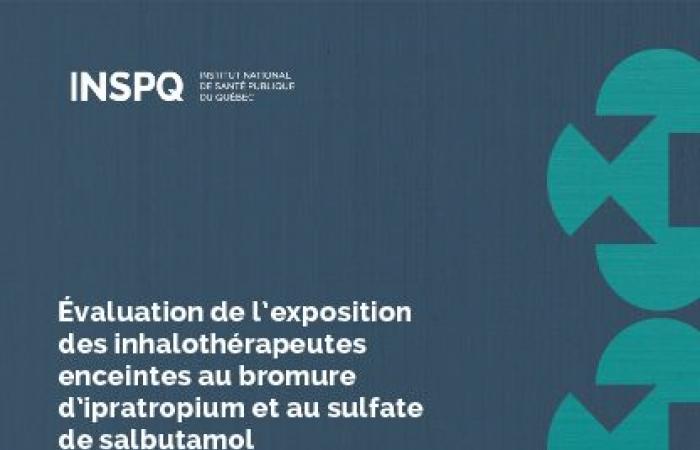
Highlights
At the request of the Provincial Medical Community for Harmonization of the For a Safe Maternity Program (CMPH-PMSD), the Respiratory Therapy Working Group (GTI) of the National Institute of Public Health of Quebec (INSPQ) carried out the Environmental characterization of a respiratory therapist’s workstation during the administration of ipratropium bromide and salbutamol sulfate in aerosols by nebulization. This characterization was carried out using ambient air samples in which the concentrations of particles and drugs were measured. Pharmacokinetic modeling completed the environmental characterization in order to estimate the dose of drug found in the blood circulation of the pregnant respiratory therapist. In the absence of a model for ipratropium bromide, only salbutamol sulfate was modeled.
Main results
- Respiratory therapists are exposed to ipratropium bromide and salbutamol sulfate when they administer these aerosolized medications by nebulization. The results of the environmental sampling reveal that with each sample, both drugs were detected in the respiratory therapist’s respiratory zone.
- The level of occasional exposure of respiratory therapists varies from one treatment to another. It is influenced by the patient’s state of respiratory health, the system used for drug administration, the perforated mask generating the most particles in the ambient air, the ventilation system in place and the occurrence of events during the treatment.
- The cumulative exposure level also varies, this time depending on point exposure levels and the number of treatments administered during the shift.
- As ipratropium bromide and salbutamol sulfate are not substances regulated by the Occupational Health and Safety Regulation in force in Quebec, the manufacturers’ reference values for workers were used as comparative. In all cases, the measured concentrations and their statistical parameters were lower than the reference values. However, in the absence of information provided by manufacturers, a question remains whether these reference values are safe during pregnancy.
- In light of the results of pharmacokinetic modeling of the fate of salbutamol sulfate in the body of the pregnant respiratory therapist and her fetus, the probabilities of exceeding the levels presumed to pose no risk to their health are significantly higher during the seasonal peak which corresponds to the flu season, during which a greater number of patients are treated with inhalation therapy. To remain below the above-mentioned level values, the frequency of nebulized salbutamol sulfate treatments administered by a pregnant respiratory therapist should not exceed five treatments per half-day, or eight treatments per day.
Limits
The approach has limitations linked to environmental sampling of medications which has so far only been carried out in adult care settings. No action was taken in the pediatric care setting. Added to this are the particular environmental conditions that prevailed at the time of the sampling carried out in a pandemic context, the small number of samples collected, the maximum number of treatments administered during a sampling day which did not exceed six treatments and the limitations inherent in pharmacokinetic modeling. These limitations must be taken into account when generalizing the results to contexts other than those prevailing at the time of the project.
Conclusion
From a prevention perspective, to reduce the exposure of pregnant respiratory therapists, healthcare settings can rely on the presence of an effective ventilation system in the premises where aerosol nebulization treatments are administered, for a maximum number of treatments. per shift and the use of HEPA filters on mouthpieces.
Canada





